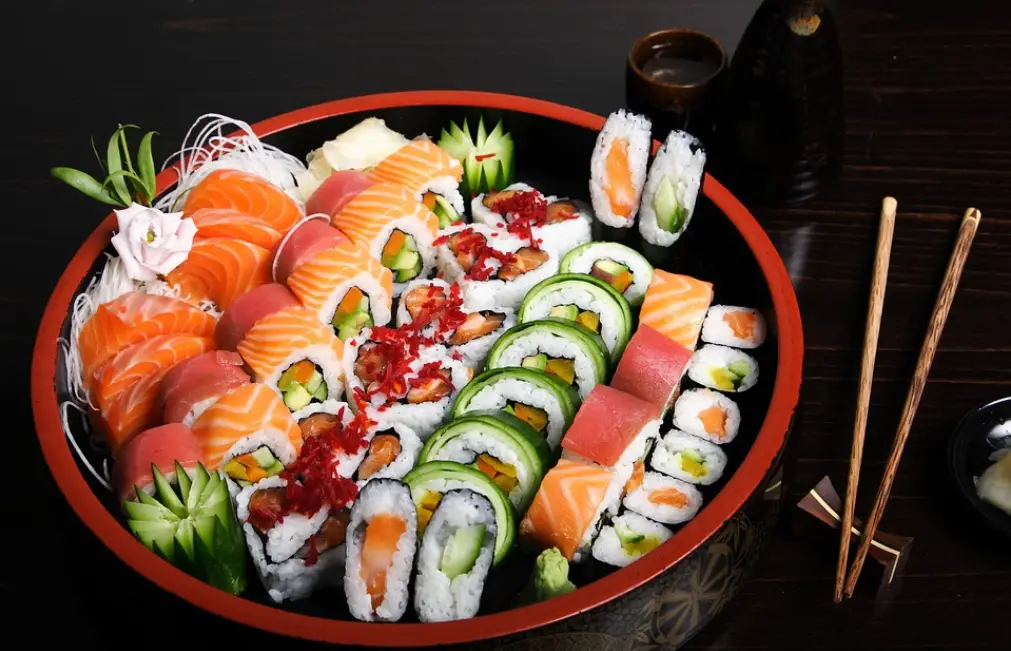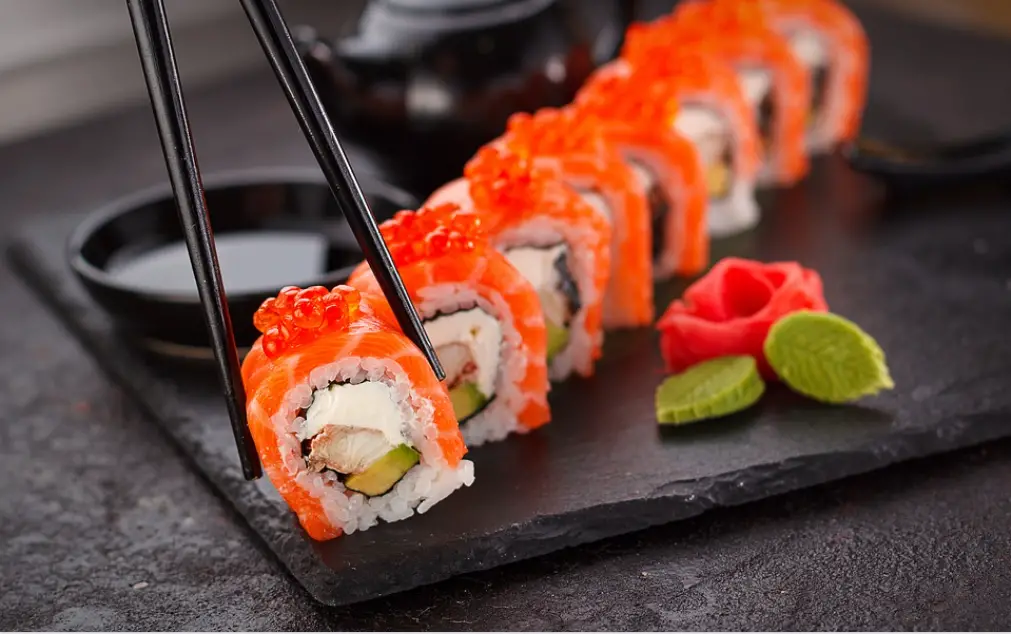If you’re on a low FODMAP diet, sushi is likely one of the foods you miss the most. The good news is that many types of sushi are low FODMAP, so you can enjoy them without worrying about your digestive health. In this blog post, we’ll discuss which types of sushi are safe to eat on a low FODMAP diet, as well as how to order them at your favourite sushi restaurant.
What Is Sushi And What Are The Different Types
Sushi is a Japanese dish that typically consists of vinegared rice, seafood, and vegetables. The word “sushi” actually refers to vinegar-seasoned rice, rather than seafood or vegetables. Sushi is often made with raw fish, but it can also be made with cooked fish or vegetarian ingredients. Sushi is typically served in bite-sized pieces, and it can be eaten with chopsticks or by hand.

The food originated in Japan, and it is thought to have originated as a way to preserve fish. The fish was salted and fermented, and then wrapped in rice. This prevented the fish from spoiling, and it also enhanced its flavour. Eventually, the fermentation process was eliminated, and sushi became the dish that we know today.
Nowadays, sushi is a popular dish all over the world. It is often considered a delicacy, and it can be found in restaurants of all kinds. Whether you’re in the mood for traditional sushi or something more creative, there’s a sushi restaurant out there for you.
Sushi is a popular Japanese dish that is traditionally made with rice, seaweed, and fish. While sushi can be a healthy and delicious option, it is important to be aware that it is not automatically low in FODMAPs. If you are following a low FODMAP diet, it is essential to check the ingredients of your sushi before you eat it.
Rice is a high FODMAP food, so if your sushi is made with plain white rice, it is not going to be low in FODMAPs. However, there are some types of sushi that use alternative types of rice, such as brown rice or sushi rice (a type of short-grain rice that has been cooked with vinegar), which may be lower in FODMAPs. It is also possible to find sushi that is made without any rice at all – these options are typically called sashimi.
The other main ingredient in sushi is seaweed. Seaweed is generally considered to be low in FODMAPs, but there are some types (such as wakame) that are higher in FODMAPs than others. Once again, it is important to check the ingredients list on your sushi before you
Different Types Of Sushi
Nigiri
Nigiri is a type of sushi that is made with vinegared rice and a topping. The topping can be fish, shellfish, vegetables, or egg. Nigiri is usually bite-sized and easy to eat.
The most common type of nigiri is tuna nigiri. To make tuna nigiri, the sushi chef prepares a block of raw tuna by removing the skin and bones. Next, they cut the tuna into thin slices. Finally, they shape the slices into small balls and press them onto balls of vinegared rice.
Nigiri can be made with any type of sushi-grade fish. Other popular types of nigiri include salmon nigiri, yellowtail nigiri, and eel nigiri. It is typically served with soy sauce and wasabi on the side. When eating nigiri, it is traditional to dip the fish side of the sushi into the soy sauce. However, some people prefer to dip the rice side instead. Wasabi can be added to the taste.
Maki
Maki is a type of sushi that is rolled inside out so that the rice is on the outside and the nori seaweed sheet is on the inside. The filling ingredients are placed in the centre of the nori sheet, and then the whole thing is rolled up into a cylindrical shape. Maki is typically served in slices, with each slice containing a bit of each ingredient. There are many different types of maki, but some of the most popular include tuna maki, salmon maki, and cucumber maki. Maki can be a simple and elegant way to enjoy sushi, and it’s perfect for both beginners and experts alike.
Temaki
If you’re a fan of sushi, then you’ve probably had temaki before. Temaki is a type of sushi roll that is wrapped in nori (seaweed) and typically filled with rice and fish. While temaki is often made with raw fish, it can also be made with cooked fish or vegetables. Temaki can be a great option if you’re looking for a quick and easy meal. And unlike other types of sushi, temaki can be easily made at home. So if you’re in the mood for sushi but don’t want to go out, why not give temaki a try?
Uramaki
Uramaki is a type of sushi that is wrapped in seaweed on the outside, rather than rice. It is often considered to be a more modern style of sushi, as it was only introduced in the early 20th century. Uramaki is usually made with fish or vegetables, although there are many variations. It is often served with soy sauce and pickled ginger and can be enjoyed as a light meal or snack. Whether you are a sushi enthusiast or just starting to explore this popular cuisine, uramaki is definitely worth trying!

Which Types Of Sushi Are Low FODMAP?
The types of sushi that are low FODMAP include nigiri, maki, temaki, and uramaki. Nigiri is made with vinegared rice and a topping, while maki is rolled with the rice on the outside. Temaki is wrapped in nori and filled with rice and fish, while uramaki is wrapped in seaweed on the outside. All of these types of sushi are low FODMAP and can be enjoyed by people who are following a low FODMAP diet.
If you’re following a low FODMAP diet, there are a few things you should keep in mind when enjoying sushi. First, be sure to choose nigiri, maki, temaki, or uramaki as these are all low FODMAP options. Second, avoid soy sauce as it is high in FODMAPs. Instead, opt for tamari or coconut aminos. Finally, be careful with wasabi as it can sometimes trigger symptoms in people with IBS. If you’re sensitive to Wasabi, start with a small amount and increase it slowly to find your tolerance level.
Recipes For Making Your Own Low FODMAP Sushi
Making your own low FODMAP sushi is a great way to enjoy this popular cuisine without having to worry about triggering your symptoms. There are many recipes available online, so you can easily find one that suits your taste. Some of the most popular low FODMAP sushi recipes include salmon nigiri, cucumber maki, and tuna uramaki. So if you’re looking for a delicious and easy meal, why not give one of these recipes a try?
Related Posts:
2